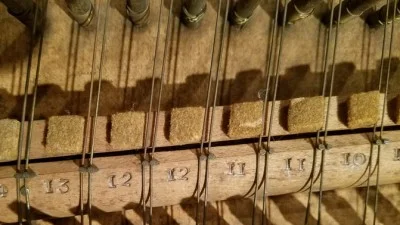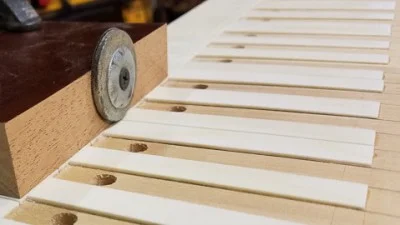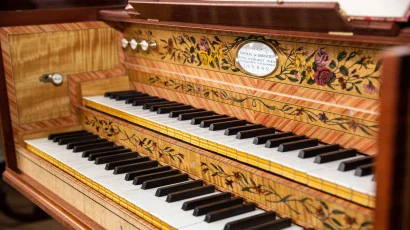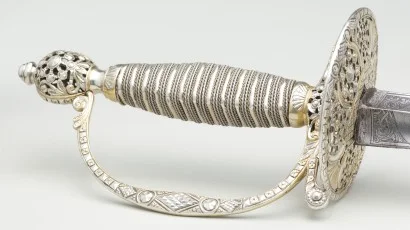For over two and a half years, John Watson, Conservator of Early Keyboard Instruments, worked to create a replica of Nelly Custis's 1793 Longman & Broderip 2-Manual Harpsichord.

In 1793, George Washington acquired a large harpsichord for his step-granddaughter, 14-year-old Eleanor Parke Custis. Of the several musical instruments that graced Mount Vernon, none was more grand or impressive than this harpsichord.
The instrument was ordered from Longman & Broderip, the largest firm of music merchants in London. It arrived at the executive mansion in Philadelphia around the midpoint of Washington’s presidency and moved with the family when they returned to Mount Vernon.
The harpsichord is remarkable for its musical gadgetry and shows the lingering importance of harpsichords during a time when the piano was becoming the dominant stringed keyboard instrument. This harpsichord’s many gadgets for changing the sound were efforts to keep up with changing tastes.
Hand stops control three sets of strings (two at normal pitch and one an octave higher) and a pedal gives the ability to change several stops at once. A buff stop makes a softer sound as if plucking the strings of a guitar. Another stop plucks the strings very near the ends to create a more nasal tone. A second pedal operates a “Venetian swell.” Pressing it opens a set of louvers like Venetian blinds, enabling the player to crescendo or decrescendo; a feat more naturally achievable on a piano. By the end of the 1790s, harpsichords would no longer be produced in any quantity until their popularity surged once again in the twentieth century.
Where has it been?
Washington’s harpsichord was eventually moved to Arlington House, the home of Nelly’s younger brother. His daughter, who inherited Arlington along with the harpsichord, married Robert E. Lee and eventually saw to the instrument’s return to Mount Vernon where it remained until its recent temporary loan for the Changing Keys exhibit at Colonial Williamsburg.

Objectives
There were two objectives for this project:
- Make a thorough examination of the 1793 original harpsichord producing comprehensive drawings and notes about its design and evidence of construction methods.
- Make a working replica of the instrument.
Listen to the Harpsichord
Phase 1: In-depth Examination and Documentation
Examination, documentation, and minor stabilization conservation of the original instrument. This was completed by August 2016 by John Watson in the Instruments Conservation Lab at The Colonial Williamsburg Foundation. The harpsichord was examined and disassembled as much as reasonably possible without breaking glue seams. Materials were identified, all components measured, and the original construction was studied. Internal clues included pencil markings, scribe lines, tool marks, glue runs, and signs of wear and early use.
Interior of soundbox during examination
Detail of soundbox interior during examination
Detail of soundbox interior during examination
Detail of soundbox interior during examination
Measuring sound board thickness non-invasivel using a Hacklinger gauge
Jacks of two unisons with millimeter ruler
Jacks and registers in context
Original wire gauge markings on the nut
Some strings may be original, but past replacements are difficult to distinguish
Taking a sample of the finish under a handstop lever to identify the coating
Detail of the swell hardware
Detail of the machine stop hardware
Phase 2: Reproduction of the Harpsichord
Making the Jacks
The jacks are the mechanical heart of the harpsichord. They hold the pieces of leather that pluck the strings and demand the highest level of precision and workmanship to work reliably. There are 244 jacks in the instrument, each consisting of only two main parts: a jack body of pearwood and a tongue of holly wood. There is also a hand-formed staple of tinned brass and a spring of boar's bristle.
Cutting top profile on tongues before cutting apart
Fly cutter in drill press used for several shaping operations
Fly cutter forming narrow bristle groove
Plectrum mortises formed with piercing tool in drill press
Hand filing plectrum mortises
Each tongue gets 6 facets cut into corners to shape and lighten
Trimming tongue corner with a jig
Jacks ready for final assembly
Making the Keyboards
This harpsichord has two keyboards of the standard late eighteenth-century compass of five octaves FF-f3. The keys rest on a keyframe and are guided by tinned brass pins. The limewood for these key levers was imported from England. It is slightly denser than basswood, which is the more common wood used for keyboards in America. The original keyboard has ivory keys, whereas we have substituted bone. The sharps are solid ebony.
Clamping the bone naturals on a go-deck during gluing
First step in shaping bottom of keys
Key panel almost ready for gluing
Cutting the decorative scribe line into the natural heads
Detail of bone natural covers after scoring and before keys cut apart
Brass front and balance pins prepared for tinning in the period manner using granules of pure tin, water, potassium bitartrate (cream of tartar), and ...
Tinning balance pins on a hotplate
Newly tinned balance pins not yet separated from granules of tin
Lower manual keyframe before adding balance rail
Upper manual keyframe in clamps
Completed keyboard with six keys turned upside down showing relief shaping of underside
Completed keyboards ready for installation
Bending the Bentside
The harpsichord's curved side is called the bentside. It is a hefty, 13 inch wide plank of 3/4-inch thick oak. The end to be curved was boiled for 45 minutes in a 55-gallon drum and bent over a shaped form and the bentside left to dry for a month.
Constructing the Pieces
A variety of the pieces were constructed including the tuning pin block, the music desk, and the trestle stand.
Making the Case
The cases of virtually all late 18th century English harpsichords are made of solid oak, then covered with decorative and sometimes figured veneers. Dovetails were cut into the oak sides, any interior surfaces veneered, and the case assembled with glue. Structural framing inside prepared the case to withstand thousands of pounds of string tension.
Silent No More
Frequently Asked Questions

Why not restore the original harpsichord rather than make a reproduction?
While the instrument could be restored to playing condition today more would be lost than gained. The harpsichord is one of the best preserved examples of its type in the world. The leather plectra (the pickers that pluck the strings), many of the strings, and even the cloth dampers are original. These parts would be the first to go in a restoration, yet they are exceptionally rare survivals and of great interest to keyboard historians.
The harpsichord is formally inscribed "Longman & Broderip," but they were only dealers and not makers. Who actually made the harpsichord?
An early theory pointed to Longman & Broderip’s biggest (though not their only) supplier. Thomas Culliford & Co. had a major contract to supply spinets, harpsichords, and pianos exclusively through Longman & Broderip.
However, a 1996 refinishing of the exterior of the harpsichord turned up an informal pencil inscription inside on the bottom boards. It read, "Hamilton Harpsichord...". Was Hamilton the maker? It is highly unlikely that any maker skilled enough to create this complex instrument would leave no other documentary evidence of being a harpsichord maker at that time. Instead, Hamilton could have been the music merchant who was in London, perhaps acting as a middle-man.
The most compelling evidence for the harpsichord's actual maker comes from another inscription. This one is on a key lever and says only "Gray." It was common for journeymen in keyboard workshops to add their own name on the component in which they had a major hand. Recent research revealed that Gray worked for Culliford where he signed at least one other Longman & Broderip harpsichord, an 1785 example that is also informally signed "Culliford & Co."

Will the reproduction harpsichord be an exact copy of the Washingtons' original?
The materials required for the reproduction such as wood, leather cloth, and various metals, and the human touch that shapes them each vary too much to make an absolutely identical copy. Additionally, we are using bone instead of ivory for the keys. Few can tell the difference even up close. We might get the precise colors of the now-faded marquetry slightly wrong since we can only guess what the original colors were.
One of the most important determinants of the instrument's sound are the leather plectra but we cannot know how similar our leather is to the original or how they voiced the instrument. We are using the same species of wood for the all-important soundboard, and will contour its thickness very like the original. In all of these details we must rely on our best educated guess and intuition to reconstruct the musical ideal they worked to achieve.
The project was made possible with funding from The Life Guard Society of Historic Mount Vernon, The Brown Foundation, Inc., The Stella Boyle Smith Trust, Deborah McManus, Mr. and Mrs. James D. Penny, J.W. Pepper & Son, Inc. and Heather Karen Hunt
Music at Mount Vernon
While Washington himself might not have been musically inclined, all four of his grandchildren studied it.
Learn more











































































